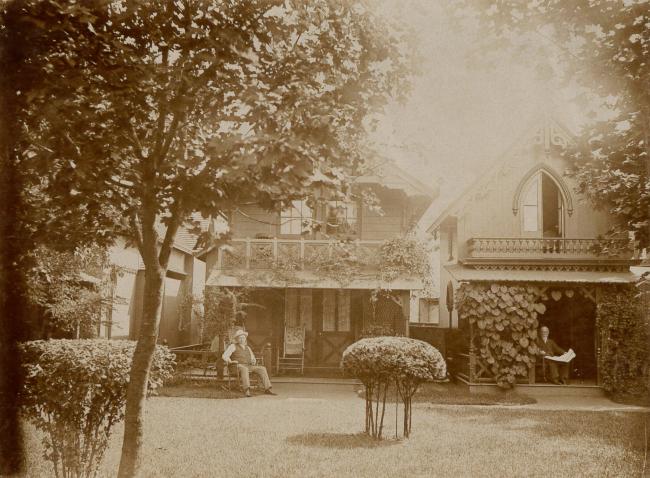The Camp Ground at Oak Bluffs is now on the National Register of Historic Places. Michael J. Connolly, secretary of state for the Commonwealth and the new chairman of the Massachusetts Historical Commission, made the news public.
The Camp Ground, Mr. Connolly said, is an area “unique in the nation for its architecture, remarkable state of preservation and as the best example of a nineteenth century religious retreat.
“The Camp Ground was a part of the mid-nineteenth century religious revivalism movement. Once a year the faithful from all over New England would gather for a weekend of intensive religious worship. At first communal tents were brought to the retreat to house the many hundreds of participants. Slowly privately owned houses, on much the same scale as the tents, were built with communal eating and meeting places still used,” he said Jan. 30. “These gingerbread or Gothic style cottages are structurally unparalleled in American architecture. During the 1870s the Camp Ground cottages were prototypes advertised in design catalogues.”
The Martha’s Vineyard Camp Meeting Association, which owns the , land on which the cottages stand, and the Oak Bluffs Historical Commission assisted in the nomination made by the Massachusetts Historical Commission. But Andrea Gilmore, an intern at the commission who was specially taken with the Camp Ground during visits, was the spur to its nomination, one spokesman for the state historical commission said this week.
Membership on the National Register protects the Camp Ground from federally sponsored activities which might damage or alter it, and it makes possible grants to the association or individual cottage owners for restoration and maintenance work.
From the February 16, 1979 edition of the Vineyard Gazette:
Editorial: On the National Register
“Surely the Lord is in this place,” wrote Hebron Vincent in his history of the Martha’s Vineyard Camp Meeting. The original nine tents which “meekly skirted the little cleared spot” increased from year to year until there were 40 or 50 big tents in the main circle, “besides the extensive groups of little family cottages spread around in the rear.”
And then, after 10 years more: “ ‘The Israelites dwelt in tents;’ so do most of us here. But why should more substantial houses be thought inconsistent with the character of the place?” Mr. Vincent quoted the words of a visitor: “The Martha’s Vineyard Camp Ground may truly be called a city in the woods...”
So grew the community of the Camp Ground, its cottages typically built with “a pretty little veranda” and with three or four feet of garden before it. Over the front door there was usually a balcony, and the “high-peaked roofs, the balconies, the door and window frames” were “all decorated with scroll work; stained glass, silver doorplates, hanging lanterns” were beheld at every turn. And the cottages were gaily painted.
So one looks back at the history of the Camp Ground, now at long last entered upon the National Register of Historic Places. The chief value of this recognition may well be the grants that should be available to the cottagers to keep their architecture in its genuine originality, not shorn of decoration by the force of economy in this age of high costs, including high-priced cottage gingerbread. The paring down of the federal budget may cheat us of some of this, but one hopes not of all.
Being on the National Register does not of itself guarantee security always. An organization known as the Save Historic Charleston Fund declares that “the historic architectural character of Charleston is now facing its greatest crisis with a City Hall plan to destroy a block of old buildings that are on the National Register of Historic Places.” Why? In order to erect a $45 million high-rise hotel-convention center complex in the heart of the Old City. The complex, of course, would serve visitors wanting to have seen the historic block of buildings that has been torn down for their convenience. Things seem to be much the same all over.











Comments